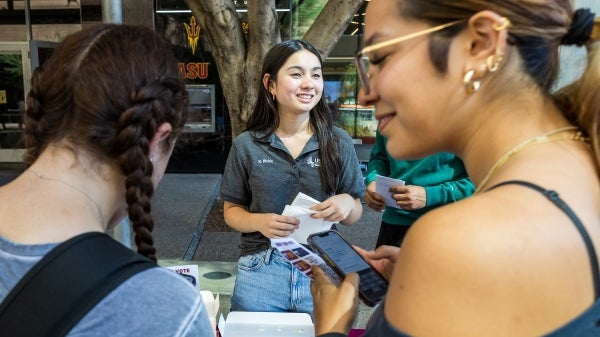ASU borderlands editor on the capture of 'El Chapo' and what's ahead

Some people spend their first day on the job figuring out the office email system or how to work the coffeemaker. Alfredo Corchado spent his first day at ASU in interviews, answering questions from media outlets about the recent capture of fugitive drug lord Joaquin “El Chapo” Guzman.
"Yep. I had just combed my hair and was sitting at orientation," said Corchado (pictured above). " 'Welcome to ASU,' I thought."
Corchado serves as the new editor of the borderlands desk of Cronkite News at Arizona PBS and is the former Mexico City bureau chief for the Dallas Morning News. He knows plenty about Guzman, who was arrested Friday after a six-month manhunt.
The arrest came after an intense gun battle between Guzman’s cartel and the Mexican authorities in the city of Los Mochis, near Guzman’s home. While the kingpin’s capture is a moment for celebration, it is also a moment for examination of Mexico’s justice system, which is widely perceived to be inept and corrupt.
Corchado, who is Southwest Borderlands Initiative professor and Professor of Practice in ASU's Walter Cronkite School of Journalism and Mass Communication, spoke to ASU Now about Guzman’s capture and what it means for Mexico, the United States and the justice system.
Question: Guzman’s story is eerily similar to Pablo Escobar’s. How are the two men’s stories alike, and how do they differ?
Answer: They are alike in that they epitomize the profile of Mexicans. More than half of the country lives in poverty; most of them have no education. Guzman epitomizes this group of society in that they take the law into their own hands and with luck they become millionaires. In his case, he is a billionaire. He and Escobar had the whole Robin Hood aura about them. Guzman and Escobar were beloved by regions of the country. I think the big difference is, unlike Escobar, Guzman did not blow up a plane with airline passengers or government institutions and buildings. He did not commit terrorist acts and didn’t go to that length, but that doesn’t mean he is not a bloodthirsty trafficker. I think that’s been proven time and again. U.S. officials say he is to be blamed for hundreds, if not thousands, of deaths in Mexico and the United States in places like Chicago, Arizona and Texas.
Q: His escape was an engineering marvel: the mile-long tunnel appeared as if it were guided by military-style GPS. It went right up to his cell, was equipped with a motorcycle, and was estimated by engineers to cost around $1 million. What does that say to you?
A: One of the important things about the capture is for U.S. and Mexican officials to sit down with Guzman and find out just how vast the web of corruption is that exists in Mexico. That’s why there will be lots of cries for extradition. You’ve got to get him to the United States to face justice. Hopefully in that process they’ll find out how high up is the corruption. When a million-dollar tunnel like that is built, that indicates a lot of things to me. It was very elaborate. It had ventilation, lighting, the whole works, and Guzman is known for elaborate tunnels in and around the border. This particular tunnel was a marvelous feat of engineering on his part.
Q: Guzman’s escape from the maximum-security prison Altiplano, 55 miles west of Mexico City, was a huge embarrassment to the Mexican government, who reportedly refused help from the United States. Why did they refuse our help in the July manhunt?
A: There’s a lot of theories on that. They might have refused their help officially, but since the manhunt began in July, the U.S. has been working with Mexican Marines, who are considered the most trusted part of their armed forces. So if you talk to U.S. and Mexican officials, they might say officially they’re not cooperating but unofficially they are exchanging intelligence since he escaped.
Q: How much of a role do the drug cartels have on the Mexican economy?
A: It’s big in the sense that the cartels employ between 500,000 to 700,000 people in Mexico. It’s a huge, huge impact on their economy. But more than anything, I think that officials are worried what it does to Mexico’s rule of raw, which is virtually nonexistent. Ninety-five percent of all crimes in Mexico are never really solved, and that’s attributed to organized crime and criminal networks who thrive and rule with impunity throughout the country.
Q: How much of an effect does proposed legalization of marijuana in the U.S. have on the cartels?
A: We’ve seen that the Mexican cartels are adaptable and this country has seen a rise in heroin use in the last few years. So they will adapt to the market in the United States. If it’s not marijuana, it’ll be something else. Again, all of this points to the rule of law.
Q: Do you believe there will now be better cooperation between Mexico and the United States in the apprehension of drug lords?
A: I don’t know about better cooperation. We’ve seen in the last few weeks more extraditions to the United States. We saw a handful of them last fall. Mexico is starting to send more key criminals to the United States because they’ve seen what the consequences are. This is tied to the popularity of President Enrique Peña Nieto, so now there’s more reason for Mexico to consider extradition, especially the extradition of Guzman. Today the president said, “Mission accomplished,” but the people don’t really feel that way until Guzman is extradited to the United States and faces justice for the crimes he’s committed.
Q: Mexico banned the death penalty years ago, but surveys and media outlets in Mexico have reported that its citizens are fed up with criminals who kidnap and murder. Do you believe the death penalty in Mexico might stem the tide?
A: There is a big debate in Mexico whether they should have the death penalty because there is a feeling that the government is soft and the criminals are not being punished. I think that Mexico has yet to learn how to punish its sons and daughters. There is growing frustration from Mexican citizens about the lack of justice in the country.
Q: What can be done to improve justice in Mexico?
A: Creating a rule of law. Society must also cultivate a thirst for journalism that looks at its people and government. That’s not going to happen overnight. It will take years for this to take shape, and it must take place at the grassroots level. I think Americans take for granted that if you commit a crime, there is a process for justice — an investigation, a trial and a sentence. That doesn’t really exist in Mexico today.
More Local, national and global affairs

Thunderbird at ASU, AUK student appointed as Ukraine’s deputy minister of education and science
Nadiia Kuzmychova, a student in the Master of Leadership and Management (MLM) program at Thunderbird School of Global Management at Arizona State University and the American University…

ASU creates pathways to public service careers for military students
The School of Public Affairs at Arizona State University is making careers in public service easier to access for military students.Next year, the school will start holding graduate courses on site…

Minting community leaders and stellar citizens: ASU’s Public Service Academy approaches 10-year milestone
Airports that are easier to navigate.Health care that is simple to access.Helping underrepresented youth reach college.These are realities that alumni of Arizona State University’s Public Service…